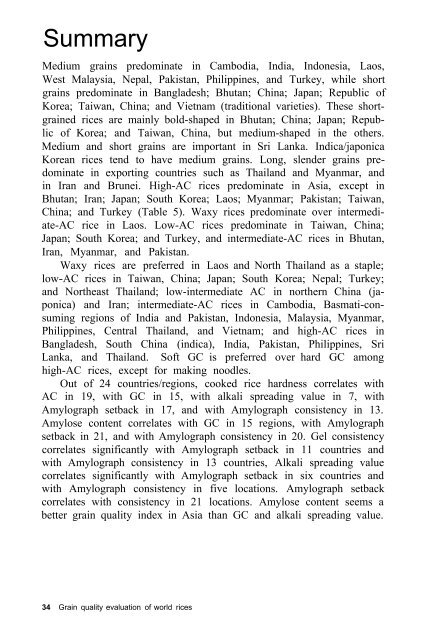Juliano et al. - 1993 - Grain Quality Evaluation of World Rices
Juliano et al. - 1993 - Grain Quality Evaluation of World Rices
Juliano et al. - 1993 - Grain Quality Evaluation of World Rices
Create successful ePaper yourself
Turn your PDF publications into a flip-book with our unique Google optimized e-Paper software.
Summary<br />
Medium grains predominate in Cambodia, India, Indonesia, Laos,<br />
West M<strong>al</strong>aysia, Nep<strong>al</strong>, Pakistan, Philippines, and Turkey, while short<br />
grains predominate in Bangladesh; Bhutan; China; Japan; Republic <strong>of</strong><br />
Korea; Taiwan, China; and Vi<strong>et</strong>nam (tradition<strong>al</strong> vari<strong>et</strong>ies). These shortgrained<br />
rices are mainly bold-shaped in Bhutan; China; Japan; Republic<br />
<strong>of</strong> Korea; and Taiwan, China, but medium-shaped in the others.<br />
Medium and short grains are important in Sri Lanka. Indica/japonica<br />
Korean rices tend to have medium grains. Long, slender grains predominate<br />
in exporting countries such as Thailand and Myanmar, and<br />
in Iran and Brunei. High-AC rices predominate in Asia, except in<br />
Bhutan; Iran; Japan; South Korea; Laos; Myanmar; Pakistan; Taiwan,<br />
China; and Turkey (Table 5). Waxy rices predominate over intermediate-AC<br />
rice in Laos. Low-AC rices predominate in Taiwan, China;<br />
Japan; South Korea; and Turkey, and intermediate-AC rices in Bhutan,<br />
Iran, Myanmar, and Pakistan.<br />
Waxy rices are preferred in Laos and North Thailand as a staple;<br />
low-AC rices in Taiwan, China; Japan; South Korea; Nep<strong>al</strong>; Turkey;<br />
and Northeast Thailand; low-intermediate AC in northern China (japonica)<br />
and Iran; intermediate-AC rices in Cambodia, Basmati-consuming<br />
regions <strong>of</strong> India and Pakistan, Indonesia, M<strong>al</strong>aysia, Myanmar,<br />
Philippines, Centr<strong>al</strong> Thailand, and Vi<strong>et</strong>nam; and high-AC rices in<br />
Bangladesh, South China (indica), India, Pakistan, Philippines, Sri<br />
Lanka, and Thailand. S<strong>of</strong>t GC is preferred over hard GC among<br />
high-AC rices, except for making noodles.<br />
Out <strong>of</strong> 24 countries/regions, cooked rice hardness correlates with<br />
AC in 19, with GC in 15, with <strong>al</strong>k<strong>al</strong>i spreading v<strong>al</strong>ue in 7, with<br />
Amylograph s<strong>et</strong>back in 17, and with Amylograph consistency in 13.<br />
Amylose content correlates with GC in 15 regions, with Amylograph<br />
s<strong>et</strong>back in 21, and with Amylograph consistency in 20. Gel consistency<br />
correlates significantly with Amylograph s<strong>et</strong>back in 11 countries and<br />
with Amylograph consistency in 13 countries, Alk<strong>al</strong>i spreading v<strong>al</strong>ue<br />
correlates significantly with Amylograph s<strong>et</strong>back in six countries and<br />
with Amylograph consistency in five locations. Amylograph s<strong>et</strong>back<br />
correlates with consistency in 21 locations. Amylose content seems a<br />
b<strong>et</strong>ter grain qu<strong>al</strong>ity index in Asia than GC and <strong>al</strong>k<strong>al</strong>i spreading v<strong>al</strong>ue.<br />
34 <strong>Grain</strong> qu<strong>al</strong>ity ev<strong>al</strong>uation <strong>of</strong> world rices

















